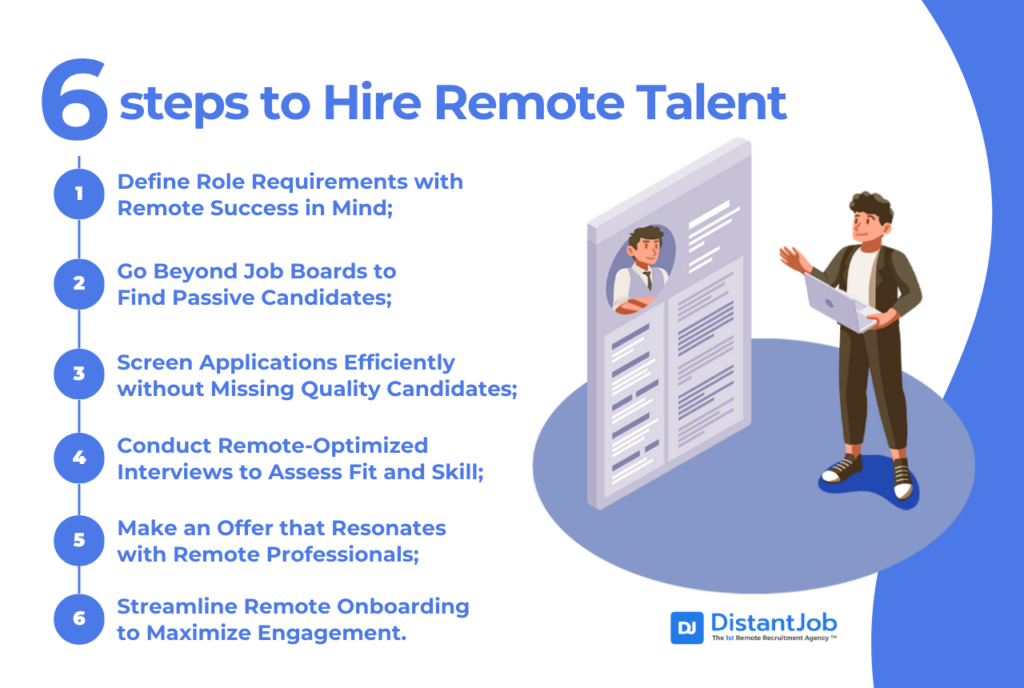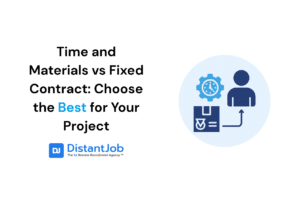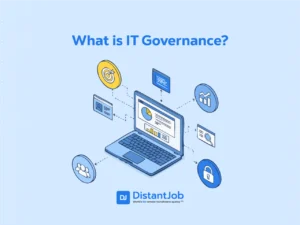You already know that hiring remotely will give you access to top talent while lowering your salaries by 40%. But how do you do it right from the start so you don’t end up with an employee who ghosts you in the first month, or worse, it’s not producing?
Hiring remote talent is more straightforward and complex than local hiring.
Simple because the formula for success is clear: find exceptional people who are both technically brilliant and natural communicators. Complex because you need to look beyond the usual metrics and really understand what makes someone thrive in a remote environment.
With 33% of companies struggling with remote hiring challenges, learning this process gives you a significant competitive advantage in today’s distributed workforce landscape.
Remote Hiring in 2025: What’s Changed?
Jump to 2025, remote hiring is no longer novel because virtual teams outperform traditional setups. It is no wonder remote-friendly jobs now account for more than 15 percent of America’s job listings, nearly triple the number what it was in 2020.
Remote work setups attract and retain better talent. The best talent wants flexibility and trust. Nearly two in three candidates now demand location flexibility when considering jobs. Not to mention that continued return-to-office measures backfire, driving experienced workers toward companies that offer unrestricted remote work.
With the new laws protecting the remote employees, you’ll need to factor in the wave of pay‑transparency laws that obligate employers to post salary ranges in every listing, making geo‑adjusted compensation models a must‑have rather than a nice‑to‑have.
6 Proven Steps to Hire Top Remote Talent in 2025

Remote hiring succeeds when you treat clarity as a non‑negotiable. Before a job ad goes live, translate every responsibility into a measurable outcome, list the exact tools the hire will use, and spell out the time‑zone overlap you truly need. That level of detail weeds out mismatched applicants and sets the right expectations from day one, cutting mis‑hire risk and early churn.
Below is a detailed breakdown of each step:
1. Define Role Requirements with Remote Success in Mind
As you would for any on-site role, you need to describe what the job entails. This will guide you toward writing a clear job description and attracting the right candidates. So, outline specific responsibilities, required skills, and experience level needed for the job.
But since this is a remote position, go a step further and include the technical and soft skills essential for working off-site. Most remote roles require strong written communication, self-motivation, time management, and proficiency with tools like Slack, Zoom, and project management platforms.
Then, assess remote-friendliness:
Ask yourself:
- Can the job be done entirely off-site?
- Will remote work impact team collaboration or client communication?
- Are all tools/software needed for the role accessible remotely?
If the answer to most of these is “yes,” your role is well-suited for a remote hire.
Lastly, determine the type of engagement you want (full-time or part-time). The project and your budget will mainly decide this. For instance, part-time hires are cost-effective for short-term work, while a big budget can accommodate full-time employees.
Once you’ve ticked these boxes, you can create the job description. When writing the job role, remember to focus on outcomes, not requirements. Instead of “2+ years PHP experience,” write “Build scalable web applications that improve user experience by 30%.”
2. Go Beyond Job Boards to Find Passive Candidates
The next step is to find top candidates for the role. Now, the traditional approach is to post your job ad on traditional job boards like Indeed or social networking platforms like LinkedIn. There are even remote job boards like Remotive.
However, while these sources are good, they aren’t great. They don’t usually attract the best candidates. The very best at what they do are hardly scrolling on job boards. These professionals are already employed, so they are not actively job searching.
Here’s a table to help you determine which method is right for you:
| Method | Success Rate / Impact | Best For |
|---|---|---|
| Specialized recruitment agencies | ~70–80% placement success with remote/adapted sourcing | Remote technical roles, cultural fit, global compliance |
| Employee referrals | Referred hires stay ~70% longer | Culture fit, retention in remote teams |
| Niche communities (GitHub, Stack Overflow) | High engagement and quality for developers | Remote developer roles |
| Professional networks (LinkedIn, remote boards) | ~60% of hires, especially via remote-focused groups | Mid-to-senior remote professionals |
| Traditional job boards | Lower remote-specific success (~40–50%) | Entry-level or non-specialized remote roles |
The best candidates aren’t actively job searching; they must be headhunted from their current positions.
3. Screen Applications Efficiently
Be prepared to get hundreds of applications coming in, and going through every entry manually is impractical and time-consuming. Besides, even if your job description is clear, you’d still get many applications from unqualified candidates.
Dovetail revealed that out of 225 applications per role, 90% of the candidates didn’t read the job description entirely, and 85% didn’t have the core skills for the job.
So, you need to find a solution that balances efficiency with thoroughness in evaluating candidates.
The key is to nail your vetting process. We’re talking about thorough technical assessments, yes, but more importantly, evaluating how candidates handle real-world remote scenarios. Do they communicate proactively? Can they work asynchronously? Are they problem-solvers who take initiative?
This way, only the most qualified candidates advance to the next stage. Of course, this process is faster when with a remote recruitment agency like DistantJob. We can screen candidates who match your requirements and only present you with a shortlist of pre-vetted professionals.
This saves you countless hours of reviewing applications and conducting preliminary screenings.
4. Conduct Remote-Optimized Interviews
Virtual interviews have become popular, even for some on-site roles. To conduct a successful one, ensure that you have the right technology.
For technical interviews, ensure you have screen-sharing capabilities and collaborative platforms ready to evaluate candidates’ skills in real time. Some popular tools include HackerRank (tech), Codility (tech), Sales Assessment by OMG (Sales), and The English Quiz. Here’s the structure you should consider:
Technical Assessment Structure:
- Coding challenge (2-3 hours, paid)
- Live coding session (45 minutes)
- System design discussion (30 minutes)
- Cultural fit interview (30 minutes)
However, don’t just give candidates generic challenges. Top talents aren’t impressed by cookie-cutter tasks. Set tests similar to the ones they’d be working on in their actual role. The best thing is to give a paid assignment to test the candidate’s skills. It’s a win-win situation: you get a sense of how they code, and you solve a problem for your project.
Behavioral and culture-fit interviews are next, and you will probably have them on video (this is what we recommend). Zoom is the best one so far but you can also use Skype,, or Google Meets. Some practical questions you can ask during this interview include:
- Tell me about when you had to work with someone whose personality was very different from yours.
- What is the most difficult/challenging situation you’ve ever had to resolve in the workplace?
- Describe an occasion when you had to manage your time to complete a task. How did you go about it?
- What would you do if you misunderstood an important task on the job? Give an example.
5. Make an Offer that Resonates with Remote Professionals
If everything looks great, that is, the candidate passes your technical and behavioral tests, make a conditional offer. Avoid being too clever, trying to see “what else is out there.” Top talents won’t wait around too long. If the candidate ticks all your (or the most important) boxes, move forward.
Fair, transparent pay is the next pillar. With salary‑range disclosure laws expanding, publishing clear bands and using geo‑adjusted formulas is no longer optional. It shows you respect the candidate, speeds up offer acceptance, and prevents trouble.
CloudHire’s 2025 analysis shows that misaligned pay is a leading cause of offer declines and first‑year churn in remote teams. Publish pay ranges up front and use EOR services for compliant, geo‑adjusted payroll.
6. Implement Seamless Remote Onboarding
You think you’re done, but wait. The onboarding process hugely impacts whether or not employees succeed at your company. According to research, 69% of employees will stay with a company for three years if they have a great onboarding experience. Therefore, it is an essential step in the hiring process.
Although their aim is the same, a remote onboarding program will differ from an in-office one. A remote program involves preparing digital versions of contracts, NDAs (non-disclosure agreements), and other relevant documents. You’ll also need to provide digital copies of essentials like the employee handbook and other resources.
Provide the necessary tools and technology for a successful collaboration, such as hardware, software, and access to company systems. If your budget allows it, you can send new laptops and other equipment directly to their homes.
The next step is to assign a buddy to help your new hire navigate their first few weeks, answer questions, and guide company protocols and culture. Additionally, provide accessible resources and a clear roadmap for their first 90 days to encourage productivity and integration.
Essential Tools for Remote Hiring
Core Technology Stack
Video Interviewing Platforms
- Zoom – Industry standard with recording capabilities
- Google Meet – Simple, browser-based solution
- Microsoft Teams – Best for Microsoft-integrated companies
Technical Assessment Tools
- HackerRank – Comprehensive coding challenges
- CodeSignal – Real-world programming tasks
- Codility – Algorithm and data structure focus
Applicant Tracking Systems
- Greenhouse – Advanced filtering and analytics
- Lever – User-friendly interface
- BambooHR – All-in-one HR solution
Background Verification
- Checkr – Fast, comprehensive background checks
- Sterling – Global verification services
- HireRight – Employment and education verification
How to Attract Top Remote Talent
Now you know the process for recruiting remote talent. Let’s discuss how to optimize your hiring strategy to attract and retain the best candidates.
1. Familiarize yourself with local employment laws
Research the employment and labor laws of the regions of potential employees before you get far in the hiring process. Understand working hours, minimum wages, benefits, and termination procedures, among other things.
2. Don’t limit your talent pool to a single location
Many companies new to remote hiring only hire within a specific city, state, region, or time zone. The transition to remote work can be overwhelming; we get it. But you miss out on enjoying the full benefit of remote recruitment when you create these restrictions. Cast a wider net, and you will give your company a real chance to hire the best of the best.
3. Set clear expectations
Explicitly define job roles, responsibilities, and performance goals. Regularly review and provide feedback on performance. In the same vein, establish communication channels and protocols. Determine the communication tools, meeting frequency, and response time expectations.
4. Respect cultural differences
Be aware of cultural differences, such as holidays, communication styles, and work practices.
5. Prioritize data security
Implement robust security protocols to safeguard sensitive information. Use VPNs, multi-factor authentication systems, and encrypted communication channels to protect company data.
6. Monitor compliance
Ensure compliance with local laws and regulations by reviewing and updating your compliance practices.
Want a more straightforward way? Hire top talent with DistantJob
So there you have it: the steps to hiring remote talent and tips for ensuring a successful process. Apply them when recruiting for your small business, and you will reap the benefits of tapping into the global talent market.
Still feeling overwhelmed by the complexities of international hiring? Let us shoulder that burden for you. At DistantJob, we’ve perfected the art of remote tech recruitment, delivering exceptional developers 60% faster than the industry average. Our specialized IT recruiters handle everything – from sourcing and vetting candidates to managing contracts, payroll, and international compliance. Plus, our money-back guarantee ensures your complete satisfaction, eliminating any risk from your hiring decision. While you focus on building great products, our global legal and HR team takes care of all the paperwork and documentation, making cross-border hiring seamless.
Ready to transform your tech team? Let’s talk about finding your perfect developer – schedule a free consultation today and discover why leading companies trust DistantJob for their remote hiring needs.
Frequently Asked Questions
The most effective approach combines specialized recruitment agencies, professional networks, and niche communities. Focus on headhunting candidates rather than relying solely on job board applications.
On average, hiring remote talent takes 4-6 weeks from job posting to offer acceptance. This includes 1-2 weeks for sourcing, 2-3 weeks for interviews, and 1 week for background checks and offer negotiation.
The top challenges include: evaluating cultural fit (45%), assessing communication skills (38%), verifying technical abilities (35%), and managing different time zones (32%).
Use a multi-stage process: technical assessment, live coding session, behavioral interview, and cultural fit discussion. Always use the same tools they’ll work with daily.





